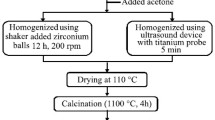Abstract
The observations and explanations for the rheological behavior associated with the slurry processing for Ca-doped BaTiO3 synthesis are included in this second part of our report. The optimum slurry conditions containing three ceramic constituents were decided by using a mixture rule after the determination of each constituent’s optimum condition. This approach was quite applicable based on the reproducibility test in determining the parameters such as water to ceramic ratio and dispersant content. In addition, a small amount of NH4OH addition without any further addition of liquid medium or dispersant was very effective in lowering the slurry viscosity when it was too high to operate the mill in our system. The optimum slurry pH range of 8.5–10.0 was suggested for high energy milling based on the experimental results. Possible models to explain this rheological behavior are also presented in terms of electrosteric mechanism and ionic exchange of dispersant molecule.











Similar content being viewed by others
References
R.J. Hunter, Introduction to Modern Colloid Science (Oxford University Press, New York, 1993), p. 97
W.S. Lee, C.H. Kim, M.S. Ha, S.J. Jeong, J.S. Song, B.K. Ryu, J. Kor. Ceram. Soc. 42(2), 132 (2005)
Y. Liu, L. Gao, Mater. Chem. Phys. 78, 480 (2002)
R.E. Mistler, E.R. Twiname, Tape Casting Theory and Practice (The American Ceramic Society, Westerville, OH, 2000), p. 45
J.A. Lewis, J. Am. Ceram. Soc. 83(10), 2341 (2000)
J.T.G. Overbeeck, The Interaction between Colloidal Particles in Colloid Science, ed. by H.R. Kruyt (Elsevier, Amsterdam, Netherlands, 1952), p. 245
J.E. Funk, D.R. Dinger, Predictive Process Control of Crowded Particulate Suspensions (Kluwer, Boston, MA, 1997), p. 57
D.J. Shaw, Introduction to Colloid and Surface Chemistry (Batterworths, Boston, MA, 1980), p. 5
S.Y. Park, S.W. Jung, Kor. Ceram. Soc. Bull. 5(3), 44 (2002)
M. Kosmulski, J. Colloid Interf. Sci. 275, 214 (2004)
U. Paik, V.A. Hackley, J. Am. Ceram. Soc. 83(10), 2381 (2000)
T. Fengqiu, H. Xiaoxian, Z. Yufeng, G. Jingkun, Ceram. Int. 26, 93 (2000)
J.K. Beattie, A. Djerdjev, J. Am. Ceram. Soc. 83(10), 2360 (2000)
R.J. Hunter, Colloid Surface A: Phys. & Eng. Asp. 195, 205 (2001)
J.H. Jean, H.R. Wang, J. Am. Ceram. Soc. 83(2), 277 (2000)
B. Utech, The Effect of Solution Chemistry on Barium Titanate Ceramics, M.S. Thesis in Solid State Science, The Pennsylvania State University, (1990), p. 1
Acknowledgements
The authors thank Dr. K. H. Hur, Mr. H. S. Jung and Mr. D. S. Lee at Samsung Electro-Mechanics Co. for their considerable cooperation.
Author information
Authors and Affiliations
Corresponding author
Rights and permissions
About this article
Cite this article
Lee, SK., Ryu, SS. & Yoon, DH. Synthesis of fine Ca-doped BaTiO3 powders by solid-state reaction method—Part II: Rheological study on milling. J Electroceram 18, 1–7 (2007). https://doi.org/10.1007/s10832-007-9000-2
Received:
Accepted:
Published:
Issue Date:
DOI: https://doi.org/10.1007/s10832-007-9000-2




